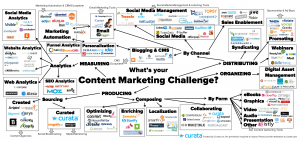The weather’s nice. The food is orange. And there are the biggest names in content marketing everywhere you look (and a constantly cursing Oscar winner to boot).
Content Marketing World is an experience full of unique character and packed to the brim with information, tips, and ideas. The speakers and attendees come from all types of backgrounds and represent just about every possible job title in the content marketing industry.
That makes for some good variety in the knowledge you walk away with at the end of the week. Here are fifteen of my favorite tidbits from those full days in Cleveland.
1) Forget funnels and focus on moments of inspiration.
Does the sales funnel still accurately reflect how people buy? With the way the internet has changed how people research and shop, Andrew Davis suggests we’re looking to an outdated tool to understand buying behavior.
There’s not a simple, linear process behind making a purchasing decision anymore. What there is now is an internet full of ideas and stories. To get the attention of your potential customers and make a connection, you need to play on the level of the things they’re paying attention to online. You need to work toward creating moments of inspiration.
2) Start using Google Trends. Yesterday.
Another tip from Andrew Davis who insists that Google Trends is the most underused tool in marketing today. If you want to understand what people care about, what they’re talking about, what they’re thinking about and searching for (and of course you do if you’re in marketing), Google Trends is the tool to show you.
3) Speaking of Google tools, you’re not doing enough with Google Analytics.
Andy Crestodina (another Google Trends fan) has figured out a lot of the best tricks for getting more out of Google Analytics. Trends are good for figuring out what people are thinking about more generally, but Analytics is where you figure out what they’re coming to your site for and what they’re doing when they get there.
If you use Google Analytics effectively, the data you glean can help with keyword research, topic development, and refining your strategy as you go.
4) Use tools, but don’t let them take the place of strategy.
Content marketing tools abound. We’ve got the aforementioned Google tools, a dizzying array of software, social  networks, tools for organizing your content creation process, amplifying the reach of your content, tracking performance, and so many more.
networks, tools for organizing your content creation process, amplifying the reach of your content, tracking performance, and so many more.
Kristina Halvorson offers the reminder that we can get carried away with our tools and tactics. Content marketing isn’t just about what we can do or think might be cool to do, it has to be strategic. Don’t let those tools distract from creating and sticking to a strategy.
5) Use personas. But remember, they’re not a creative writing project.
Personas are content marketing 101. We all know we need them, but the harder part is making sure they’re based on something real.
It might feel fun and creative to sit down and write out what you think is going on in the mind of your ideal customer, but unless you’re basing what goes into your persona on actual interviews or data, you’re writing fiction. Jenny Magic and Melissa Breker brought up the inconvenient truth that for personas to do their job and make your content marketing strategy more effective, they can’t just be a creative writing project.
 6) When creating a content strategy, saying “no” isn’t just ok, it’s important.
6) When creating a content strategy, saying “no” isn’t just ok, it’s important.
This is another gem from Kristina Halvorson (and one of the pieces of advice on this list that can easily extend to life beyond content marketing). Marketers are creative people and, as such, we tend to have more ideas than we can reasonably execute.
An important part of developing a content strategy that will be effective and sustainable is the ability to say “no.” Producing a blog post a day, a weekly video series, and an infographic all this month might sound like a great plan – but do you actually have the resources to execute that plan? Carefully consider what you can accomplish, so you create the most effective and efficient strategy within your means.
7) Always ask “why?”
Another Halvorson tip: think like a five year old. Every step of putting together your strategy and creating your  content, ask “why?” Why are you doing this? Why is this important?
content, ask “why?” Why are you doing this? Why is this important?
Just keep asking until you get down to those big, hard-to-answer philosophical questions. If your content answers everything up to that point, you know you’ve dug deep into something really useful.
8) Writing is not grammar, it’s thinking.
You may have noticed a few sentences in this post that start with “and” or “but.” Well Ann Handley told me I could 🙂 .
The grammatical rules that may have seemed like gospel when you were learning to write in school aren’t the most important part of writing well. In fact, any time they have a negative influence on the readability or personality of your content, they should be set aside.
What matters is the thought that goes into the work. Writing must be useful and meaningful and something your reader can relate to. More than any proper use of a semi-colon, that’s what makes writing good in the world of content marketing.
9) Whenever you could use some extra writing inspiration, check out style guides.
Do you ever look over the style guides produced by some of the companies putting out great content? I have to admit, I never really thought to, but Ann Handley recommends it as a way to keep your writing fresh.
A few she specifically recommends are:
If you know of any other good ones worth checking out, let me know,
10) If you don’t have one already, develop a plan to start connecting with influencers ASAP.
In his talk on influencer marketing, Lee Odden stressed how people are much more likely to trust experts than brands. This is a pretty intuitive point: how much more likely are you to make a decision based on the advice of a person you trust versus that of a brand?
That makes any expert in your industry with an engaged audience somebody you want to know. And more to the point, somebody that you want to know and trust you well enough to share your content. This isn’t easy though, you need a plan to best determine which influencers you want to connect with and how best to establish, nurture, and maintain that connection.
11) Be sure to target actual influencers, not just people that are popular.
It’s possible for someone to have a large following and obvious popularity, without being a person with influence. Odden explains the distinction: a brandividual is popular, but an influencer can create popularity.
Popularity might be measured in things like followers, but an influencer is likely to have a more engaged audience. Their followers aren’t just passive listeners, but make a point to interact and become a part of the their community. That’s how you tell the difference.
12) But don’t just target the already influential, look for people on their way up.
Every powerful influencer out there started as someone with no fans or audience. The road to cultivating influence is long and slow and most of those who reach the end get some help along the way. And they remember the help they got.
Says Odden, “Work with an influencer, they’re friends for a day. Help someone become influential and they’re a friend for life.” Keep your eyes open for the people who are on their way up and look for opportunities to connect with them as well.
13) Get ready for adaptive content.
Context plays a huge role in how and why people buy. How huge of a role? It turns out that personalized content can mean 3-10 times as many conversions.
Jenny Magic and Melissa Breker talked about the growing trend of adaptive content. You’ve already seen glimpses of this – things like personalized ads based on sites you’ve visited and seeing different versions of a website on different types of devices all count as adaptive content.
The technology for businesses to do even more personalization in how they deliver up content is already there; it’s just a matter of jumping in and using it. But you can’t jump in without a plan. In the mantra familiar to any and all Content Marketing World attendees: the strategy must come first.
14) Slow down and fix your shit.
Both Kristina Halvorson and Jonathon Coleman gave this line a nod. Along with #15, it’s one of those pieces of advice that’s useful in pretty much all aspects of life. Rushed work and hasty decisions rarely produce results on par with what you get out of a well thought out and carefully executed strategy. Take your time and do it right.
15) It’s all about empathy.
To produce content people want to consume, you have to understand what they like and need. We talk a lot about personas in the realm of content marketing, but we always have to remember what the real point of those personas is. They’re worthless if they don’t help us empathize with the people we’re trying to reach.
In the emphasis on getting out a large quantity of content quickly (see #14), it’s easy to lose sight of what the purpose of the content is. Catchy headlines followed by posts that repeat familiar facts might help content creators reach their quotas and satisfy the higher ups, but are you creating something that people will actually appreciate?
Always have the people on the other end of the computer screen in mind. If you’re not making an effort to empathize with their needs, it’s time to start.






